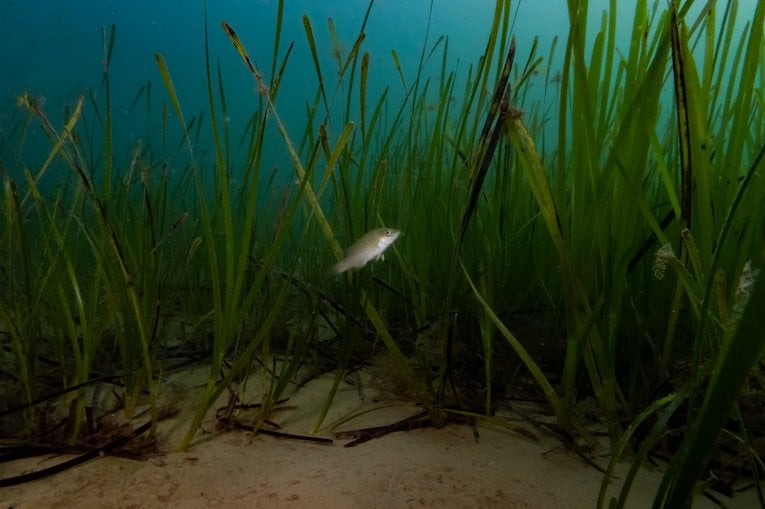Seagrass Planting: Revitalizing Scotland's Coastal Ecosystems

Table of Contents
The Ecological Importance of Seagrass in Scotland
Seagrass meadows are far more than just pretty underwater plants; they are fundamental to the health and resilience of Scotland's coastal ecosystems. Their ecological importance is multifaceted, impacting everything from climate change mitigation to supporting biodiversity.
Carbon sequestration and climate change mitigation
Seagrass meadows are highly effective carbon sinks, absorbing carbon dioxide (CO2) from the atmosphere at a rate far exceeding that of many terrestrial forests. This "blue carbon" sequestration makes seagrass planting a powerful tool in combating climate change in Scotland. The dense root systems of seagrass also help stabilize sediments, reducing coastal erosion and protecting vulnerable shorelines.
- Significant CO2 absorption: Seagrass can sequester carbon at rates up to 35 times faster than tropical rainforests.
- Coastal protection from erosion: Intact seagrass beds act as natural buffers against wave action and erosion.
- Habitat creation for biodiversity: Seagrass provides vital nursery and feeding grounds for a wide range of marine species.
Biodiversity hotspots
Seagrass beds are incredibly biodiverse habitats, providing critical nursery and feeding grounds for a wide range of commercially and ecologically important species. Many fish, shellfish, and seabirds rely on seagrass for survival, making their protection crucial for maintaining the health of Scotland's fisheries and overall marine biodiversity. In Scotland, species such as the common sole, seahorses, and various crustaceans depend on healthy seagrass meadows.
- Nursery grounds for fish: Many commercially important fish species rely on seagrass beds as nurseries for their young.
- Feeding grounds for invertebrates: Seagrass provides food and shelter for a multitude of invertebrates, which in turn support larger predators.
- Habitat for endangered species: Some endangered species, like certain seahorses, are highly dependent on seagrass for survival.
Water quality improvement
Seagrass meadows act as natural filters, improving water clarity and reducing pollution. Their dense root systems trap sediments and absorb excess nutrients, leading to clearer water and a healthier marine environment. This improved water quality, in turn, benefits other marine life and supports human activities such as recreation and tourism.
- Nutrient filtration: Seagrass absorbs excess nutrients, preventing harmful algal blooms.
- Sediment stabilization: The root systems stabilize sediments, preventing turbidity and improving water clarity.
- Reduced turbidity: Clearer water allows sunlight to penetrate, supporting photosynthesis and enhancing overall ecosystem health.
Seagrass Planting Techniques and Challenges in Scotland
Seagrass planting is a complex undertaking, requiring careful planning and execution. Several techniques are employed, each with its own challenges in the specific environmental context of Scotland.
Seed collection and propagation
Seed collection and propagation are crucial first steps in successful seagrass planting. Methods involve carefully collecting ripe seeds from existing healthy seagrass beds, then propagating them in controlled environments before transplantation. Challenges include ensuring seed viability, selecting suitable planting sites with appropriate environmental conditions (light, salinity, sediment type), and optimizing planting times to maximize seedling survival.
- Seed viability: Maintaining high seed viability during collection, storage, and propagation is essential for success.
- Suitable planting sites: Careful site selection is crucial to ensure suitable environmental conditions for seagrass growth.
- Optimal planting times: Planting should be timed to coincide with optimal environmental conditions for seedling establishment.
Planting methods and restoration projects
Several methods are used for seagrass planting, including direct seeding and transplanting seedlings. Direct seeding involves broadcasting seeds directly onto the seabed, while transplanting involves planting pre-grown seedlings. Successful seagrass restoration projects in Scotland, like those undertaken by various conservation organizations, demonstrate the effectiveness of these techniques when implemented appropriately.
- Direct seeding: A cost-effective method suitable for large areas, but with lower initial success rates.
- Transplanting: A more labor-intensive approach with higher initial survival rates, but suitable for smaller areas.
- Monitoring and evaluation: Ongoing monitoring and evaluation are essential to assess the success of planting efforts and adapt strategies as needed.
Environmental considerations and sustainability
Sustainable seagrass planting practices are paramount to avoid unintended negative consequences. This involves minimizing disturbance to existing habitats, carefully choosing planting sites to avoid sensitive areas, and employing long-term monitoring to assess the ecological impacts. Careful consideration of potential risks, such as accidental damage to existing ecosystems during planting, and developing effective mitigation strategies, are essential.
- Minimizing disturbance to existing habitats: Planting efforts should be carefully planned to minimize any impact on existing ecosystems.
- Choosing appropriate planting sites: Careful site selection is crucial to ensure the long-term success of planting efforts.
- Long-term monitoring: Ongoing monitoring is vital to assess the long-term success and ecological impacts of seagrass planting.
The Role of Community Involvement and Government Initiatives
Successful seagrass planting initiatives require collaboration between scientists, community groups, and government agencies.
Citizen science and volunteer programs
Citizen science and volunteer programs play a crucial role in supporting seagrass planting and monitoring efforts. These initiatives provide opportunities for the public to get involved in practical conservation work, contributing to data collection and raising awareness about the importance of seagrass.
- Volunteer planting events: Community participation in planting events boosts restoration efforts and fosters environmental stewardship.
- Data collection and monitoring: Citizen scientists can assist with collecting vital data on seagrass growth and health.
- Educational outreach: Volunteer programs can educate the public about the ecological significance of seagrass and the importance of conservation.
Government policies and funding
Government policies and funding are essential to support seagrass restoration projects. Policies that protect seagrass habitats, regulate activities that threaten seagrass meadows, and provide funding opportunities for conservation initiatives are crucial for long-term success. Various funding programs and grants are available in Scotland for seagrass conservation projects.
- Funding programs: Government funding supports research, restoration projects, and community engagement initiatives.
- Environmental regulations: Strong regulations are needed to protect seagrass habitats from damaging activities.
- Policy support for restoration: Clear policy support is crucial to provide a framework for successful seagrass restoration.
Conclusion
Seagrass planting is not merely an environmental initiative; it's a vital strategy for safeguarding Scotland's coastal ecosystems and contributing to a healthier planet. By restoring these valuable seagrass meadows, we can enhance biodiversity, improve water quality, combat climate change, and create more resilient coastal communities. The combined efforts of scientists, community groups, and government initiatives are crucial for the continued success of seagrass planting projects across Scotland. Get involved today and help revitalize Scotland’s coastal ecosystems through active participation in seagrass planting or supporting relevant organizations. Let’s work together to protect this valuable resource for future generations and ensure the continued health and prosperity of Scotland's coasts.

Featured Posts
-
 Breaking Down The Ufc Des Moines Fight Card Predictions And Betting Tips
May 04, 2025
Breaking Down The Ufc Des Moines Fight Card Predictions And Betting Tips
May 04, 2025 -
 The Count Of Monte Cristo A Comprehensive Review For Modern Readers
May 04, 2025
The Count Of Monte Cristo A Comprehensive Review For Modern Readers
May 04, 2025 -
 Ufc 314 Betting Odds A Comprehensive Guide To The Opening Lines
May 04, 2025
Ufc 314 Betting Odds A Comprehensive Guide To The Opening Lines
May 04, 2025 -
 Razlad Kupera I Di Kaprio Slukhi I Realnost
May 04, 2025
Razlad Kupera I Di Kaprio Slukhi I Realnost
May 04, 2025 -
 Russell Westbrooks Game Against The Warriors Fan Reactions And Highlights
May 04, 2025
Russell Westbrooks Game Against The Warriors Fan Reactions And Highlights
May 04, 2025
